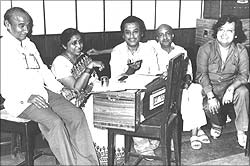The 50s and 60s was the Golden Period of Bollywood. It was the period that saw the Hindi cinema with melodious socials and melodramas with melodious & immortal songs.The films made during that time not only gave entertainment but also social & moral message..this period saw the production of some of India’s most critically acclaimed directors, actors and actresses,Music Directors,Lyricist and films of all time.
V SHANTARAM -
In 1929, he founded the Prabhat Film Company along with Vishnupant Damle, K.R. Dhaiber, S. Fatelal and S.B. Kulkarni, which made Ayodhyecha Raja, the first Marathi language film in 1932 under his direction.He left Prabhat co. in 1942 to form "Rajkamal Kalamandir" in Mumbai. In time, "Rajkamal" became one of the most sophisticated studios of the country. Through his 66-year-old career, was known to use cinema as an instrument to effect social change, advocate humanism and expose bigotry and injustice. He was also interested in music and actively participated in the music creation and production of his films. He was also remembered to have ‘ghost-written’ music for many of his music directors.He is most known for films such as Dr. Kotnis Ki Amar Kahani (1946), Amar Bhoopali (1951), Jhanak Jhanak Payal Baaje (1955), Do Aankhen Barah Haath (1957), Navrang (1959),
BIMAL ROY
- He is particularly noted for his realistic and socialistic films such as Do Bigha Zamin, Parineeta, Madhumati, Sujata, and Bandini, making him an important director of Golden Era of Hindi cinema.He was a filmmaker of great and in-depth understanding of human strengths and weaknesses.He introduced the genius composer Salil Chowdhury to Hindi Cinema with Do Beegha Zameen , but also utilised his writing skills in at least three films. Do Beegha was based on a story Rikshawala written by him back in the ’40s. Parakh was also based on his story and Salil da wrote the screenplay of Prem Patra .
MEHBOOB KHAN -
The maker of bold saga Aurat (1940),Anmol Ghadi (1946), the romantic drama Andaz (1949), the swashbuckling musical Aan (1951) and the grand social epic Mother India (1957).He set up his production company – Mehboob Productions, and later a film studio – Mehboob Studios in Bandra, Mumbai in 1954.
K ASIF -
A film director, film producer and screenwriter who is famous for his work on the Hindi epic motion picture, Mughal-e-Azam (1960)..His directorial debut, Phool (1945), did very well at the box-office due to the casting of and portrayals by famous actors and actresses of the time such as Prithviraj Kapoor, Durga Khote and Suraiya. He became a successful director due to his perfectionism in weaving his imagination into an art form and gave birth to Mughal-e-Azam, a legendary film in the Indian Film Industry. He died at age 48.
Raj Kapoor
Raj Kapoor is regarded as one of the greatest and most influential actors and filmmakers in the history of cinema.[5] He was the winner of several accolades including 3 National Film Awards and 11 Filmfare Awards in India. He was a two-time nominee for the Palme d'Or grand prize at the Cannes Film Festival for his films Awaara (1951) and Boot Polish (1954).He established R K Studio in 1948 and became the youngest film director of his time making his directorial debut with Aag starring himself, He went on to produce and star in several hit films made under his R. K. Banner including Awaara (1951), Shree 420 (1955), Jagte Raho (1956) and Jis Desh Men Ganga Behti Hai (1960)
B R CHOPRA -
He was one of the architects of golden era,Best known for making Hindi films like Naya Daur (1957), Sadhna (1958), Kanoon (1961), Gumrah (1963) and Humraaz (1967).His first film as a director, Afsana, was released in 1951 and featured Ashok Kumar in a double role – the film was a hit and established his name in Bollywood. Chopra made Chandni Chowk, with Meena Kumari as a lead, in 1954. In 1955, B.R. formed his own production house, B.R Films. His first movie for this production house was the highly successful Naya Daur (1957) starring Dilip Kumar and Vyjayantimala Bali, the film became a golden jubilee hit. He was instrumental in developing the career of singer Mahendra Kapoor,
GURU DUTT -
He was an Indian film director, producer and actor. He made 1950s and 1960s classics such as Baazi, Pyaasa, Kaagaz Ke Phool, Sahib Bibi Aur Ghulam and Chaudhvin Ka Chand. In particular, Pyaasa and Kaagaz Ke Phool are now included among the greatest films of all time, both by Time magazine's "All-TIME" 100 best movies.His first film as Director, Navketan's Baazi, was released in 1951..He also produced Aar Paar 1954 and C I D in 1956.
VIJAY ANAND-
Also known as Goldie Anand, was a filmmaker, producer, screenwriter, editor and actor, who is known for acclaimed films such as Guide (1965) and Johny Mera Naam (1970). He made most of his films for the in-house banner Navketan Films.He was also the director of Teesri Manzil(1966).He gave us the films like Nau Do Gyarah(1957), Kala Bazar (1960),Tere Ghar Ke Samne (1963),Jewel Thief (1967),Tere Mere Sapne (1971).
Actors of Golden Era
The three most popular male Indian actors of the 1950s and 1960s were Dilip Kumar, Raj Kapoor, and Dev Anand, each with their own unique acting style.Other actors were Ashok Kumar. Balraj Sahni,Guru Dutt,Shammi Kapoor, Rajendra Kumar,Johny Walker and Mehmood while successful actresses included Nargis, Suraiya, Vyjayanthimala, Meena Kumari, Nutan, Madhubala, Sadhana, Waheeda Rehman and Mala Sinha.
Music Directors Of Golden Era
Naushd,S D Burman,Shankar Jaikishan,O P Nayyar.Madan Mohan,C Ramchandra.Hemant Kumar and Roshan were few of the great composer of that time.
Singers of Golden Era
Lata,Geeta Dutt,Asha Bhosle,Suriya among the female Rafi,Talat Manna De Mukesh and Kishore Kumar were among the male singers.


























